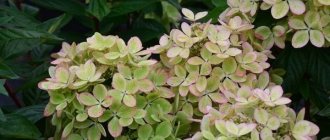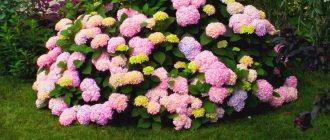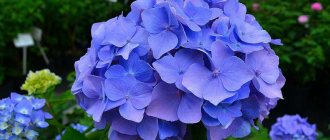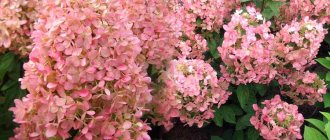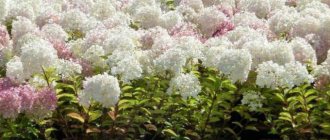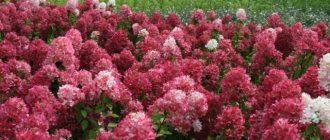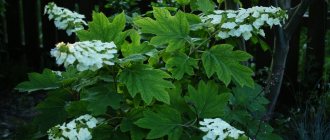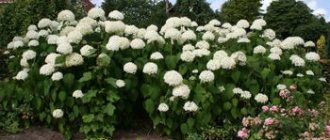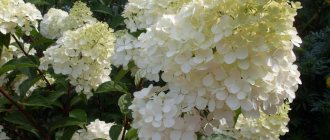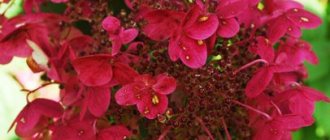My husband and I bought a summer cottage to make it look more cozy, I decided to plant a small flowering bush at the entrance. Of all the options, I liked rough hydrangea the most.
My husband and I bought a couple of hydrangea seedlings at the nursery, planted them according to all the rules, and a year later, at the beginning of summer, gorgeous lilac flowers bloomed on them. Now our yard begins to look very cozy and attractive. In this article I will describe the rough hydrangea and tell you how to properly care for it.
Description
Rough hydrangea grows in the form of a bush, not exceeding 1.5 meters in height. Such low growth is easily explained, since this variety is frost-resistant, which means it is planted in cold regions. Every winter, the upper part of the bush freezes, so the hydrangea is forced to be reborn every year. If you cover it well before the onset of winter, then it is guaranteed to bloom next season.
In July, small purple and large white or lilac flat inflorescences bloom on its tree-like stems. Flowering ends in September-October, but in southern climates it can continue until November. They have large, velvety, dark green leaves that turn orange-brown in late summer.
Varieties of hydrangeas that grow successfully in Russian areas:
- Paniculata.
- Oakleaf.
- Chereshkova.
- Sargent.
- Serrated.
- Macrophylla.
These varieties most often do not differ from each other in appearance, but have their own resistance to climate, pests and diseases. Therefore, for your climate, you need to select a certain plant variety so that it successfully takes root and blooms profusely.
Varieties of rough hydrangea
Currently, there are several varieties of rough hydrangea. In addition, constant work is underway to obtain new ones. Below are the most popular varieties of this crop.
Macrophila
The height of this hydrangea is 1.5 m. It has rough leaves covered with small hairs. Their length reaches 35 cm, width - up to 20 cm. The inflorescences are quite large - in some specimens the diameter reaches 20 cm. Hydrangea rough Macrophila is shown in the photo below.
The spherical inflorescences of this variety have a variety of shades; in general, the color of the plant depends on the acidity of the soil
Important! The more alkaline the soil, the paler the hydrangea flowers. On acidic soils they are blue, on alkaline soils they are pink or lilac.
Sargent
The height of the crop can reach 4 m. One of the most popular varieties with velvety leaves. The main feature of this variety is a gradient change in color within one inflorescence and a smooth transition from lilac to pink (and then to blue) over the area of the entire bush. In addition, on some plants the petals may be either white or have a white edge.
Flowering is quite late and long-lasting, it begins in September and lasts until the first frost.
Hot Chocolate
A variety introduced relatively recently. It has huge inflorescences - up to 30 cm in diameter.
The leaves of this variety also change color, but, unlike the classic change from green to orange, it has a transition from silver to olive
The color of the shoots also changes over time: as the temperature drops, they turn red.
Important! The Hot Chocolate variety, even without foliage, is highly decorative due to its characteristically colored stems.
Landing
This shrub does not like drafts and shade, but it also does not want to stay in sunny places for a long time, so partial shade, protected from the winds, is best suited for it. If you plant the hydrangea in a sunny place, its petals may burn out. She prefers fertile, neutral soil; it is not advisable to plant it in acidic soil. Planting is done in mid-spring or early autumn.
The diameter of the pit should be at least 50 centimeters and the depth about 70 centimeters. Then a little drainage layer is poured onto the bottom of the hole, then filled to the middle with a fertile substrate of peat and sand. After this, the seedling is placed in the hole, making sure that the root collar is above ground level. The roots are covered with soil and watered thoroughly with warm water; the procedure is completed by mulching the tree trunk circle with shavings or pine needles.
Planting and caring for rough hydrangea
Planting and caring for rough hydrangea is not particularly difficult. The only thing you should pay close attention to is watering, since the plant needs a lot of moisture.
Selection and preparation of a landing site
The ideal place for rough hydrangea is an area sheltered from the wind in partial shade. The soil must be nutritious and have a pH level of at least 5.0 (slightly acidic).
Preliminary preparation of a site for rough hydrangea consists of clearing it of weeds and applying mineral fertilizers (up to 20 g of superphosphate per 1 sq. m). This must be done two weeks before planting. Usually, it is carried out in the spring.
Before planting, a rough hydrangea seedling should be treated with a growth stimulator by immersing its roots, for example, in Epin's solution. Immediately before installing it in a hole, it is recommended to spray it with a 0.2% solution of potassium permanganate to disinfect it from fungi and pests.
Landing rules
Planting is carried out according to the following scheme:
- Dig a hole 60 cm deep and 70 cm in diameter.
- A drainage layer of coarse crushed stone or broken brick is laid at the bottom.
- Pour 15-20 cm of soil mixture into the hole.
- A seedling is placed in it.
- Sprinkle with soil to the top and tamp lightly.
- Irrigate with 20-30 liters of water.
After planting, the plant is not watered for a week, then the plant goes back to the standard watering schedule.
The first watering of rough hydrangea is carried out immediately after planting.
It is recommended to immediately mulch the bush with a layer of peat 5-10 cm high.
Watering and fertilizing
Rough hydrangea is a moisture-loving crop. Watering is done every 3-4 days. Their norm is from 30 to 50 liters of water per bush. It is advisable to update the mulch layer once every 1-1.5 months.
In the first and second years after planting, rough hydrangea is not fed. Starting from the third year, the following feeding schedule is recommended:
- April – nitrogen mineral fertilizers for increasing green mass (urea).
- June – potassium-phosphorus mineral supplements (superphosphate).
- July - organic matter (rotted manure, compost, chicken manure solution).
- September is a complex fertilizer, including potassium, phosphorus, magnesium and boron.
In the latter case, it is advisable to purchase a specialized feeding mixture for ornamental plants.
Trimming
The plant is not pruned for the first 2-3 years. Subsequently, formative and sanitary treatment of the crown is carried out 2 times a season. The first is performed immediately after the snow melts.
In the spring, in addition to removing shoots that have not overwintered, all last year's shoots are shortened to the lowest bud
Sanitary pruning is performed in the fall. It is part of preparing the plant for winter.
Preparing for winter
At the end of autumn, the plant is sanitary pruned and damaged and too old shoots are removed. After this, moisture-recharging irrigation is done and the tree trunk circle is mulched with a layer of straw, sawdust or fallen leaves up to 20 cm high. In the case of a particularly cold climate, the protective layer is covered with film or agrofibre on top.
Important! To avoid drying out in the spring, as soon as the snow melts, the film and layer of mulch should be removed.
Watering
She loves water very much, so you need to make sure that the top layer of soil does not dry out. And the tree trunk circle must be mulched so that the liquid does not evaporate ahead of time. Suitable mulch is: shavings, pine needles, foliage, bark.
During the hot season, it is watered twice a week, plus the entire top is additionally sprayed; during the rainy season, it is watered only when the soil dries out a little. If there is a layer of mulch around the trunk, then the frequency of watering can be reduced.
Hydrangea rough in landscape design
Rough hydrangea is widely used in landscape design. Large bushes can be used as a monoculture over large areas. They can be used to create dense hedges and be used as border plants for wide paths.
As a separate design element, rough hydrangea will look beyond any competition, since bright and beautiful flowers attract attention.
Decorating a bench with the Macrophila variety is a common option for using it in the landscape of a park area.
It is also good to use rough hydrangea as the central element of a large flower bed, surrounded by bushes of bright and large plants, the flowers of which will contrast with it. It looks good surrounded by variegated annuals.
Top dressing
Immediately after planting, she is given urea, potassium, and superphosphate. As soon as the first buds begin to form, the bush is given sulfuric potassium and superphosphate, but you don’t have to feed it if you plan to bloom abundantly. Before sheltering for the winter, hydrangea is fertilized with manure or compost, which will help it successfully survive the winter. And next spring, as soon as the soil warms up, it is fertilized with urea and sulfuric potassium.
Trimming
If the bush is not regularly pruned, then over time the flowering will be poor, since the green mass takes all the nutrients. And under the weight of the leaves, the bush will gradually begin to bend down to the ground, losing its decorative effect.
The main formative pruning is carried out in the spring, leaving stems 20 centimeters high. In a short time the bush will grow and become lush. If there are too many shoots, they are thinned out. Every autumn it is recommended to cut off old and weak shoots.
Reproduction
This unpretentious plant is quite easy to propagate. The most popular propagation method is cuttings, which even beginners can handle.
By cuttings
At the beginning of summer, a shoot with large buds is cut from one bush, after which it is divided into parts so that each of them has no more than three leaves. Then the lower part is placed in water with “Kornevin” for two hours, after which it is stuck into open soil consisting of peat and sand, covered with a jar to create a microclimate.
Water once or twice a week, after a month the cuttings should take root. This will be indicated by the appearance of new leaves. Then the jars can be removed, but for the winter the cuttings must be covered with leaves or covering material. They can be transplanted to another place as soon as they grow above 45 centimeters.
Seeds
The color of the petals may not be the same as on the packaging. The seed material is planted in a pot with moistened soil and covered with film or glass. Water only when the soil becomes dry. After 20 days, the first shoots should hatch. Then it is grown in the same pot for about two years, only then it is transplanted into open ground.
By layering
This procedure is carried out in early spring, until the leaves have completely blossomed from the buds. Select the side branches, make a small groove next to them, drop the middle of the selected branch into it, secure it with a pin for safety, and water it well. From time to time this place is hilled up so that the roots develop properly.
By autumn, shoots should appear on this branch, it is well covered for the winter, and in the spring the seedlings are dug up, divided among themselves and transplanted to another place.
By division
At the beginning of spring, the plant is dug up completely, the soil is washed off from the roots and the bush is divided into parts using a clean knife. Damaged roots are removed, treated with Kornevin, and transplanted to another place. The plant successfully tolerates this procedure, but it is quite difficult to dig out due to its powerful roots.
Rare types of hydrangea: Sargenta, serrated, ash and ground cover on Supersadovnik.ru
In addition to everyone’s favorite panicle, tree and large-leaved hydrangeas, there are many more species that are not so widespread, mainly because of their heat-loving nature.
For the most part, they feel great in the southern regions, but already in the middle zone and in the Moscow region they require special treatment.
We will focus on the least whimsical of them: these are Sargent hydrangeas, ashy, serrated and groundcover.
- An opportunity to surprise your neighbors with an unusual plant.
- They are not as difficult to grow as they might seem at first glance.
- They can be covered at the same time as other heat-loving crops.
Groundcover hydrangea, or heteromalla (Hydrangea heteromalla), is a shrub with a wide-rounded crown up to 2 m in diameter with reddish-brown shoots. The plant is native to the forests of Northern China. Blooms in July-August for 2-3 weeks. White flowers are collected in large inflorescences up to 16 cm in diameter. Over time, they acquire a purple tint and remain on the plant for a long time.
Varieties of ground cover hydrangea
The popular variety Bretschneideri differs from the species in having larger inflorescences. More recently, it was considered a great rarity, but now it has begun to actively appear on sale. The flowers have a greenish tint when they bloom, and at the end of flowering they turn purple. Blooms profusely.
in the photo is a hydrangea Bretschneideri
Hortensia Sargent
Sargentian hydrangea, or velvet hydrangea (Hydrangea Sargentiana), is a plant native to China. The species is decorative with its leaves - they are very large (up to 20–25 cm long), abundantly pubescent. The petioles are long, the pubescence is coarser, reddish, and on annual shoots it feels a little prickly to the touch. The foliage does not change color and remains green until cold weather.
Unfortunately, in the middle zone the plant is still quite rare. In warm regions, these are huge bushes with a height and diameter of up to 2.5 m.
in the photo is Sargent's hydrangea, or velvet
Hydrangea serrata
Serrata hydrangea (Hydrangea serrata) is a shrub with large, showy inflorescences about 1.5 m high. The leaves are elliptical, pointed at the top, up to 10 cm long. The flowers are blue or white, collected in corymbose inflorescences, blooming in July-August.
Growing conditions
Very demanding on soil fertility. More light-loving than most types of hydrangea, it can grow without shading. Blooms in the second half of summer.
variety of hydrangea serrata Veerle
Bush up to 1 m high, up to 1.5 m in diameter. Inflorescences with a diameter of 5–10 cm. Characterized by long-term flowering. It grows slowly.
in the photo there is a variety of hydrangea Veerle
variety of hydrangea serrata Bluebird
Bush up to 1.5 m high. Inflorescences are flat, umbrella-shaped, up to 10 cm in diameter. Flowers range from light purple to bright blue. The variety needs shelter for the winter. A distinctive feature is the large number of inflorescences even in young plants.
variety of hydrangea serrata Preziosa
Compact bush up to 1–1.2 m high. Hemispherical inflorescences up to 12 cm in diameter. At the beginning of flowering, the flowers are yellowish-green, then pinkish, and crimson by autumn. Soil acidity does not affect the color of flowers. Inflorescences form on last year's shoots.
in the photo there is a serrated hydrangea at the end of October
Ash hydrangea
Gray or ashy hydrangea (Нydrangea cinerea) is a shrub with a spreading crown, 1–1.2 m high in cultivation, up to 2 m high in nature. It blooms at the ends of last year’s shoots. Small white flowers are collected in corymbose inflorescences up to 5–15 (20) cm in diameter. Flowering from mid-June to September.
Varieties
Currently represented by one variety – Sterilis. At the end of summer, the bush is decorated with inflorescences consisting of sterile (sterile) flowers reaching a diameter of 10–15 cm.
in the photo there is an ashen hydrangea
in the photo there is ashy hydrangea at the end of October - at the beginning of November
Source: https://www.supersadovnik.ru/text/redkie-vidy-gortenzii-sarzhenta-pilchataja-pepelnaja-i-pochvopokrovnaja-1007059
Care
Despite the fact that hydrangea rough macrophylla is frost-resistant, it still needs to be covered for the winter for successful development:
- Cut off all leaves, as well as diseased and old shoots.
- Carefully, so as not to break the shoots, they are divided into several bundles, which are tied together.
- After which these bundles are tilted and strengthened near the ground.
- Cover the top with covering material.
- Additionally sprinkle with fallen leaves.
- Place something heavy on top so that moisture does not accumulate under the covering material.
There is no need to be afraid that the insulation layer is too thick, she loves warmth, this is the only way she can successfully survive the winter. In the spring it is unwound only when the threat of frost has completely passed. If mold appears on the shoots, it can be washed off with clean water or a weak solution of potassium permanganate.
Diseases and pests
It is sometimes attacked by pests such as spider mites, weevils, and aphids. You can get rid of them with the help of insecticides, which are carefully sprayed over the entire top of the bush. You can get rid of aphids using a soap solution, which is used to wipe each stem and leaves with a sponge. After ten days, the procedure is repeated to get rid of the new generation of aphids.
Among the diseases she can pick up:
- Downy mildew, which appears as yellow and dark spots on the leaves. To cure the plant, it is treated with a solution of foundationazole.
- Chlorosis - when the leaves lose color, the veins remain green. The plant needs to be watered with a solution of iron sulfate. To do this, dissolve 45 grams of iron sulfate in a ten-liter bucket of water.
Reviews
- Ivanova Anastasia, 45 years old, Rostov. “I chose hydrangea to decorate my garden because it is immediately noticeable and blooms for a long time. I associate these fluffy balls with tenderness and magic. It is easy to care for; if the summer is hot, I water it more often than usual. I definitely feed it every spring and fall. I really love photographing these wonderful flowers; even on my desktop laptop there is a photograph of a plant I grew myself.”
- Fedchenko Marina, 38 years old, Kazan. “Every summer I love to watch how the hydrangea blooms and how the color of its petals changes. This is simply wonderful magic! Of course, in order for it to bloom profusely, I regularly feed it, prune it and always cover it for the winter, since in our winter the temperature sometimes drops to -35°C. I like that it doesn’t require special care, since due to work I can’t devote much time to plants.”
- Sulimova Alexandra, 51 years old, Pskov. “For her incredible flowering, I forgave her for her problematic wintering. This beauty with bright flowers quickly took root in my garden; today I have five large-leaved bushes growing. I start covering it at the end of September, since at this time the weather begins to get colder. And in May I completely remove the covering material and carry out formative pruning, thanks to which the plant grows beautifully all summer. I have never regretted that I planted this shrub, despite the hassle with wintering.”
Characteristic
Sargentian hydrangea is a deciduous shrub with erect, rigid, weakly branched shoots 1 to 2 m high. Latin name: Hydrangea aspera sargentiana. Family: Hydrangeaceae.
The plant is characterized by intensive growth - annual growth is 20-25 cm. Winter hardiness zone - 6-7 (-23°C). When grown in regions with cold and continental climates, it requires good insulation of the root area. It blooms for a long time - from the end of July until the first half of September.
- the bark on the stems is brown, peeling, and on young stems it is covered with thick, bristly hairs;
- the root system is well developed, close to the surface;
- the leaves are large, 30x15-16 cm in size, ovoid in shape with a sharp tip, emerald green above, rough, gray-green, velvety below;
- the flowers are flat, collected in umbellate or corymbose inflorescences with a circumference of 15-20 cm, color light lilac or light purple;
- At the top of the buds, several sterile white flowers with a diameter of 2-3 cm bloom.
